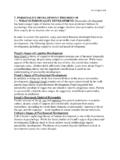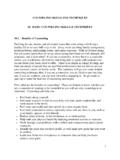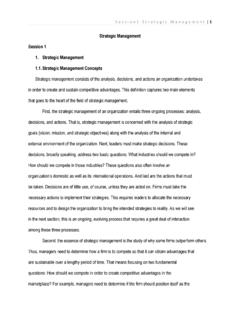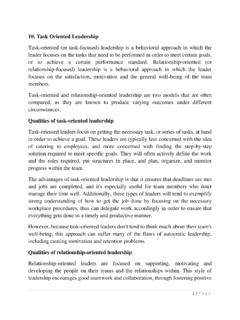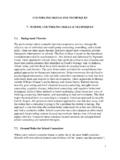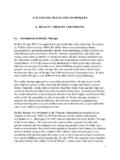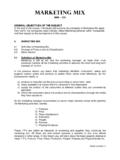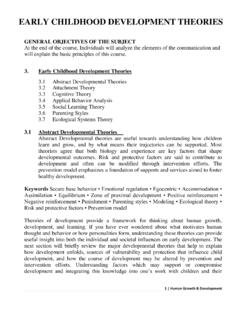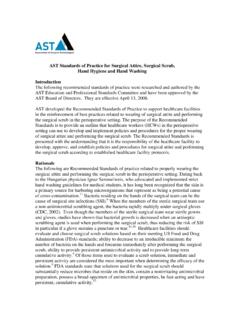Transcription of SIX THINKING HATS - Atlantic International University
1 CRITICAL THINKING SIX THINKING hats SESSION 6 CRITICAL THINKING [Pick the date] SESSION 6 Six THINKING hats 'Six THINKING hats ' is an important and powerful technique. It is used to look at decisions from a number of important perspectives. This forces you to move outside your habitual THINKING style, and helps you to get a more rounded view of a situation. This tool was created by Edward de Bono in his book '6 THINKING hats '. Many successful people think from a very rational, positive viewpoint. This is part of the reason that they are successful. Often, though, they may fail to look at a problem from an emotional, intuitive, creative or negative viewpoint. This can mean that they underestimate resistance to plans, fail to make creative leaps and do not make essential contingency plans. Similarly, pessimists may be excessively defensive, and more emotional people may fail to look at decisions calmly and rationally.
2 If you look at a problem with the 'Six THINKING hats ' technique, then you will solve it using all approaches. Your decisions and plans will mix ambition, skill in execution, public sensitivity, creativity and good contingency planning. How to Use the Tool You can use Six THINKING hats in meetings or on your own. In meetings it has the benefit of blocking the confrontations that happen when people with different THINKING styles discuss the same problem. Each ' THINKING Hat' is a different style of THINKING . These are explained below: White Hat: With this THINKING hat you focus on the data available. Look at the information you have, and see what you can learn from it. Look for gaps in your knowledge, and either try to fill them or take account of them. This is where you analyze past trends, and try to extrapolate from historical data. Red Hat: 'Wearing' the red hat, you look at problems using intuition, gut reaction, and emotion.
3 Also try to think how other people will react emotionally. Try to understand the responses of people who do not fully know your reasoning. Black Hat: Using black hat THINKING , look at all the bad points of the decision. Look at it cautiously and defensively. Try to see why it might not work. This is important because it highlights the weak points in a plan. It allows you to eliminate them, alter them, or prepare contingency plans to counter them. Black Hat THINKING helps to make your plans 'tougher' and more resilient. It can also help you to spot fatal flaws and risks before you embark on a course of action. Black Hat THINKING is one of the real benefits of this technique, as many successful people get so used to THINKING positively that often they cannot see problems in advance. This leaves them under-prepared for difficulties. Yellow Hat: The yellow hat helps you to think positively.
4 It is the optimistic viewpoint that helps you to see all the benefits of the decision and the value in it. Yellow Hat THINKING helps you to keep going when everything looks gloomy and difficult. Green Hat: The Green Hat stands for creativity. This is where you can develop creative solutions to a problem. It is a freewheeling way of THINKING , in which there is little criticism of ideas. A whole range of creativity tools can help you here. Blue Hat: The Blue Hat stands for process control. This is the hat worn by people chairing meetings. When running into difficulties because ideas are running dry, they may direct activity into Green Hat THINKING . When contingency plans are needed, they will ask for Black Hat THINKING , etc. A variant of this technique is to look at problems from the point of view of different professionals ( doctors, architects, sales directors, etc.) or different customers.
5 Example The directors of a property company are looking at whether they should construct a new office building. The economy is doing well, and the amount of vacant office space is reducing sharply. As part of their decision they decide to use the 6 THINKING hats technique during a planning meeting. Looking at the problem with the White Hat, they analyze the data they have. They examine the trend in vacant office space, which shows a sharp reduction. They anticipate that by the time the office block would be completed, that there will be a severe shortage of office space. Current government projections show steady economic growth for at least the construction period. With Red Hat THINKING , some of the directors think the proposed building looks quite ugly. While it would be highly cost-effective, they worry that people would not like to work in it. When they think with the Black Hat, they worry that government projections may be wrong.
6 The economy may be about to enter a 'cyclical downturn', in which case the office building may be empty for a long time. If the building is not attractive, then companies will choose to work in another better-looking building at the same rent. With the Yellow Hat, however, if the economy holds up and their projections are correct, the company stands to make a great deal of money. If they are lucky, maybe they could sell the building before the next downturn, or rent to tenants on long-term leases that will last through any recession. With Green Hat THINKING they consider whether they should change the design to make the building more pleasant. Perhaps they could build prestige offices that people would want to rent in any economic climate. Alternatively, maybe they should invest the money in the short term to buy up property at a low cost when a recession comes. The Blue Hat has been used by the meeting's Chair to move among the different THINKING styles.
7 He or she may have needed to keep other members of the team from switching styles, or from criticizing other peoples' points. It is well worth reading Edward de Bono's book 6 THINKING hats for more information on this technique. Key Points Six THINKING hats is a good technique for looking at the effects of a decision from a number of different points of view. It allows necessary emotion and skepticism to be brought into what would otherwise be purely rational decisions. It opens up the opportunity for creativity within Decision Making. The technique also helps, for example, persistently pessimistic people to be positive and creative. Plans developed using the '6 THINKING hats ' technique will be sounder and more resilient than would otherwise be the case. It may also help you to avoid public relations mistakes, and spot good reasons not to follow a course of action before you have committed to it Six THINKING hats A Creativity Process for Results Driven Groups A Statoil drilling manager presents his problem as a case study.
8 The group solves his problem using the Six THINKING hats method. The drilling goes on, and millions are saved. With hindsight, a genial solution--not planned and not foreseeable in advance. "The winner is the chef who takes the same ingredients as everyone else and produces the best results."--Edward de Bono Six THINKING hats is a time-tested tool that boosts creative and innovative performance. It provides a framework to focus and broaden THINKING by separating out six different ingredients in THINKING : white hat--information, yellow hat--benefits, black hat--risk, green hat--creativity, red hat--gut instinct, and blue hat--process. Each person uses the same tool, at the same time, on the same challenge--focused parallel THINKING . This cleans up the conversation, puts an end to endless debate and discussions that are going nowhere, and saves everyone time. "Six hats is a simple, yet powerful tool that can be learned rapidly and used immediately to achieve long-lasting results.
9 Six hats has helped our product development group to generate ideas quickly, evaluate them efficiently, and implement action plans effectively." - Laura Donahue, Increase creative and innovative performance by learning how to: 1. Break the idea killer habit that shuts down the creative process. 2. Generate powerful new ideas that are outside of the mainstream. 3. Follow a productive process for idea evaluation. 4. Work with benefits to determine if an idea is worthwhile exploring further. 5. Identify and assess problems at the appropriate places in the creative process. 6. Consider a broader range of possible solutions, and select the ones that best meet the business need. 7. Include "gut instinct" reactions. 8. Break the tendency to get stuck in the data and facts--information overload which constrains creative effort. 9. Set up clear focus statements to put each person on the same page and avoid confusion.
10 10. Select opportunities to pursue based on balancing value against risk. 11. Develop action plans to minimize risk. 12. Sell well thought through ideas to management and clients with more confidence. 13. Move from intellectual understanding to skill development. "The Six THINKING hats methodology was openly embraced by the advisors and we truly got much more robust output from the meeting than conventional advisory boards." - Betsey King, Professional Relations & Education Manager, AstraZeneca The Six THINKING hats Tool Kit Process control. Managing the THINKING . Focus tool. THINKING agenda development. Time management plan. Keep egos and argument in check. Action planning for next steps, roles, responsibilities, time. Data, information, facts known and needed. White hat tool other people s views. Spectrum of relevance tool. Range of accuracy tool. Plan to get necessary white hat data.
